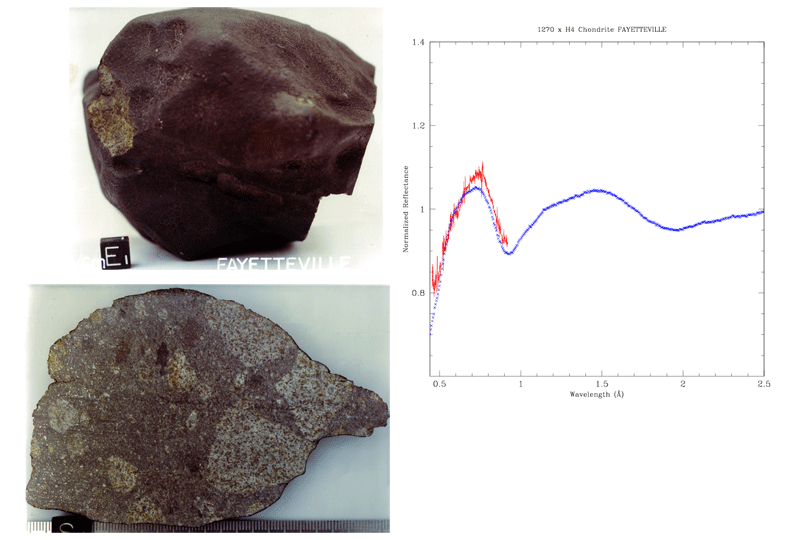A&A press release: Discovery of the source of the most common meteorites (10 July 2008)
- Details
- Published on 07 July 2008
A&A press release
Released on July 10th, 2008
|
Discovery of the source of the most common meteorites |
“Visible spectroscopy of extremely young asteroid families”, by Mothé-Diniz and Nesvorný
Published in Astronomy & Astrophysics Letters, 2008, vol. 486-2, pp. L9-L12
When observing with the GEMINI telescopes, two
astronomers from Brazil and the United States discovered for the first
time asteroids that are similar to “ordinary
chondrites”, the most common meteorites found on Earth. Until
now, astronomers have failed to identify their asteroidal sources
because of the various geologic processes that occur after the
meteorites are ejected from their asteroidal parent body. This
discovery is being published this week in Astronomy &
Astrophysics.
Astronomy & Astrophysics is publishing the
first discovery by T. Mothé-Diniz (Brazil) and D.
Nesvorný (USA) of asteroids with a spectrum similar to that
of ordinary chondrites, the meteoritic material that most resembles the
composition of our Sun. Most of the meteorites that we collect on Earth
come from the main belt of asteroids located between Mars and Jupiter
[1]. They were ejected from their asteroidal “parent
body” after a collision, were injected into a new orbit, and
they finally felt onto the Earth. Meteorites are a major tool for
knowing the history of the solar system because their composition is a
record of past geologic processes that occurred while they were still
incorporated in the parent asteroid. One fundamental difficulty is that
we do not know exactly where the majority of meteorite specimens come
from within the asteroidal main belt. For many years, astronomers
failed to discover the parent body of the most common meteorites, the
ordinary chondrites that represent 75% of all the collected meteorites.
To find the source asteroid of a meteorite, astronomers must compare
the spectra of the meteorite specimen to those of asteroids. This is a
difficult task because meteorites and their parent bodies underwent
different processes after the meteorite was ejected. In particular,
asteroidal surfaces are known to be altered by a process called
“space weathering”, which is probably caused by
micrometeorite and solar wind action that progressively transforms the
spectra of asteroidal surfaces. Hence, the spectral properties of
asteroids become different from those of their associated meteorites,
making the identification of asteroidal parent body more difficult.
Collisions are the main process to affect asteroids. As a consequence
of a strong impact, an asteroid can be broken up, its fragments
following the same orbit as the primary asteroid. These fragments
constitute what astronomers call “asteroid
families”. Until recently, most of the known asteroid
families have been very old (they were formed 100 million to billions
of years ago). Indeed, younger families are more difficult to detect
because asteroids are closer to each other [2]. In 2006, four new,
extremely young asteroid families were identified, with an age ranging
from 50000 to 600000 years. These fragments should be less affected
than older families by space weathering after the initial breakup.
Mothé-Diniz and Nesvorný then observed these
asteroids, using the
GEMINI telescopes (one located in Hawaii, the other in
Chile), and obtained visible spectra. They compared the asteroids
spectra to the one of an ordinary chondrite (the Fayetteville meteorite
[3]) and found good agreement, as illustrated on Fig. 1.

Fig. 1 - (Right)
Comparison of the spectrum of asteroid (1270) Datura with the spectrum
of the Fayetteville meteorite. (Left) Pictures of the Fayetteville
meteorite (© Arkansas Center for Space and Planetary Sciences,
University of Arkansas).
This discovery is the first observational match between the most common meteorites and asteroids in the main belt. It also confirms the role of space weathering in altering asteroid surfaces. Identifying the asteroidal parent body of a meteorite is a unique tool when studying the history of our solar system because one can infer both the time of geological events (from the meteorite that can be analyzed through datation techniques) and their location in the solar system (from the location of the parent asteroid).
[1] There are only a few exceptions, including the example of the famous meteorites coming from Mars.
[2] After the primary asteroid is disrupted, the fragments move away from each other. The older the collision, the greater the distance between fragments.
[3] Meteorites are named for the place they were collected. The Fayetteville meteorite fell near Fayetteville, Arkansas, on December 26, 1934.
Visible spectroscopy of extremely young asteroid families, by T. Mothé-Diniz and D. Nesvorný
Astronomy & Astrophysics Letters, 2008, volume 486-2, pp. L9-L12. Full article available in PDF format
Contacts:
- Science:
Dr.
Thais Mothé-Diniz
Observatório Nacional
Rua Gal. José Cristino, 77
20921-400 Rio de Janeiro, Brasil
Email: thais.mothe (at) gmail.com
Phone: +55 21 3504 9212
- Press office:
Dr.
Jennifer Martin
Journal Astronomy & Astrophysics
61, avenue de l'Observatoire
75014 Paris, France
Email: aanda.paris (at) obspm.fr
Phone: +33 1 43 29 05 41
© Astronomy & Astrophysics 2008


